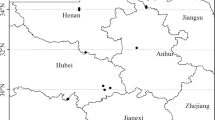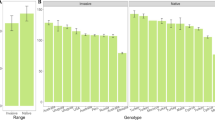Abstract
Post-introduction evolution of increased growth or reproduction has been observed in many species of invasive plants; however, it is not consistently associated with a loss of defense, as predicted by the influential evolution of increased competitive ability (EICA) hypothesis. Inconsistent support for the EICA hypothesis likely reflects the fact that, although invasive plants are released from attack by some enemies, typically specialists, they often do not escape attack from generalists. Thus, different types of defense (e.g., structural versus chemical) may evolve in different directions following introduction. We used a common garden experiment to test whether a shift in allocation among defenses (as opposed to a simple increase or decrease in a single defense) is associated with increased growth in introduced Verbascum thapsus populations. Introduced populations had significantly greater shoot biomass than natives. However, root biomass was similar between ranges, and highly variable, resulting in only marginal differences in total biomass. Mean investment in all three defenses was remarkably similar between the native and introduced populations, providing no evidence for range-level, post-introduction evolution of defense. This finding was consistent with the fact that, despite significant population-level variability for all defenses, there was little evidence of trade-offs between growth and defense or among different types of defense. These results suggest that evolution of increased growth in V. thapsus is not fueled by decreased allocation to defense, and that selection on defense may vary more at the population scale than the continental scale.


Similar content being viewed by others
References
Adler LS, Schmitt J, Bowers MD (1995) Genetic variation in defensive chemistry in Plantago lanceolata (Plantaginaceae) and its effect on the specialist herbivore Junonia coenia (Nymphalidae). Oecologia 101:75–85
Agren J, Schemske DW (1993) The cost of defense against herbivores: an experimental-study of trichome production in Brassica rapa. Am Nat 141:338–350
Alba C, Hufbauer R (in review) A biogeographic comparison of Verbascum thapsus ecology reveals differences in performance, herbivory, and surrounding plant community
Berenbaum MR, Zangerl AR (1998) Chemical phenotype matching between a plant and its insect herbivore. Proc Natl Acad Sci USA 95:13743–13748
Bergelson J, Purrington CB (1996) Surveying patterns in the cost of resistance in plants. Am Nat 148:536–558
Blair AC, Wolfe LM (2004) The evolution of an invasive plant: an experimental study with Silene latifolia. Ecology 85:3035–3042
Blossey B, Nötzold R (1995) Evolution of increased competitive ability in invasive nonindigenous plants: a hypothesis. J Ecol 83:887–889
Blumenthal DM, Hufbauer RA (2007) Increased plant size in exotic populations: a common-garden test with 14 invasive species. Ecology 88:2758–2765
Bossdorf O, Auge H, Lafuma L, Rogers WE, Siemann E, Prati D (2005) Phenotypic and genetic differentiation between native and introduced plant populations. Oecologia 144:1–11
Bowers MD (1984) Iridoid glycosides and host-plant specificity in larvae of the buckeye butterfly, Junonia coenia (Nymphalidae). J Chem Ecol 10:1567–1577
Bowers MD, Puttick GM (1988) Response of generalist and specialist insects to qualitative allelochemical variation. J Chem Ecol 14:319–334
Bowers MD, Stamp NE (1993) Effects of plant age, genotype, and herbivory on Plantago performance and chemistry. Ecology 74:1778–1791
Brewer WH, Watson S, Gray A (1876) Botany of California. Welch Bigelow and Co, University Press, Cambridge
Cano L, Escarre J, Vrieling K, Sans FX (2009) Palatability to a generalist herbivore, defence and growth of invasive and native Senecio species: testing the evolution of increased competitive ability hypothesis. Oecologia 159:95–106
Choong MF (1996) What makes a leaf tough and how this affects the pattern of Castanopsis fissa leaf consumption by caterpillars. Funct Ecol 10:668–674
Chun YJ, van Kleunen M, Dawson W (2010) The role of enemy release, tolerance and resistance in plant invasions: linking damage to performance. Ecol Lett 13:937–946
Clissold FJ, Sanson GD, Read J, Simpson SJ (2009) Gross versus net income: how plant toughness affects performance of an insect herbivore. Ecology 90:3393–3405
Colautti RI, Ricciardi A, Grigorovich IA, MacIsaac HJ (2004) Is invasion success explained by the enemy release hypothesis? Ecol Lett 7:721–733
Coley PD (1983) Herbivory and defensive characteristics of tree species in a lowland tropical forest. Ecol Monogr 53:209–233
Damtoft S (1994) Biosynthesis of catalpol. Phytochemistry 35:1187–1189
DeWalt SJ, Denslow JS, Ickes K (2004) Natural-enemy release facilitates habitat expansion of the invasive tropical shrub Clidemia hirta. Ecology 85:471–483
Dimock MB, Tingey WM (1988) Host acceptance behavior of Colorado potato beetle larvae influenced by potato glandular trichomes. Physiol Entomol 13:399–406
Elton CS (1958) The ecology of invasions by animals and plants. University of Chicago Press, 196 p
Endler JA (1986) Natural selection in the wild. Princeton University Press, Princeton
Feeny P (1970) Seasonal changes in oak leaf tannins and nutrients as a cause of spring feeding by winter moth caterpillars. Ecology 51:565–581
Fornwalt PJ, Kaufmann MR, Stohlgren TJ (2011) Impacts of mixed-severity wildfire on exotic plants in a Colorado ponderosa-pine Douglas-fir forest. Biol Invasions 12:2683–2695
Franks SJ, Pratt PD, Dray FA, Simms EL (2008) No evolution of increased competitive ability or decreased allocation to defense in Melaleuca quinquenervia since release from natural enemies. Biol Invasions 10:455–466
Gardner DR, Stermitz FR (1988) Hostplant utilization and iridoid glycoside sequestration by Euphydryas anicia individuals and populations. J Chem Ecol 14:2147–2168
Gomulkiewicz R, Thompson JN, Holt RD, Nuismer SL, Hochberg ME (2000) Hot spots, cold spots, and the geographic mosaic theory of coevolution. Am Nat 156:156–174
Gross KL (1980) Colonization by Verbascum thapsus (mullein) of an old-field in Michigan: experiments on the effects of vegetation. J Ecol 68:919–927
Gross KL, Werner PA (1978) The biology of Canadian weeds 28. Verbascum thapsus and Verbascum blattaria. Can J Plant Sci 58:401–413
Henkel A (1917) Weeds used in medicine. US Department of Agriculture Farmers’ Bulletin no. 188
Herms DA, Mattson WJ (1992) The dilemma of plants: to grow or defend. Q Rev Biol 67:283–335
Hinz HL, Schwarzlaender M (2004) Comparing invasive plants from their native and exotic range: what can we learn for biological control. Weed Technol 18:1533–1541
Joshi J, Vrieling K (2005) The enemy release and EICA hypothesis revisited: incorporating the fundamental difference between specialist and generalist herbivores. Ecol Lett 8:704–714
Kalisz S (1986) Variable selection on the timing of germination in Collinsia verna (Scrophulariaceae). Evolution 40:479–491
Keane RM, Crawley MJ (2002) Exotic plant invasions and the enemy release hypothesis. Trends Ecol Evol 17:164–170
Khan ZR, Ward JT, Norris DM (1986) Role of trichomes in soybean resistance to cabbage looper, Trichoplusia ni. Entomologia Experimentalis Et Applicata 42:109–117
Khuroo MA, Qureshi MA, Razdan TK, Nichols P (1988) Sterones, iridoids and a sesquiterpene from Verbascum thapsus. Phytochemistry 27:3541–3544
Koricheva J (2002) Meta-analysis of sources of variation in fitness costs of plant antiherbivore defenses. Ecology 83:176–190
Leger EA, Forister ML (2005) Increased resistance to generalist herbivores in invasive populations of the California poppy (Eschscholzia californica). Divers Distrib 11:311–317
Leger EA, Rice KJ (2003) Invasive California poppies (Eschscholzia californica Cham.) grow larger than native individuals under reduced competition. Ecol Lett 6:257–264
Levin DA (1973) Role of trichomes in plant defense. Q Rev Biol 48:3–15
Lewis KC, Bazzaz FA, Liao Q, Orians CM (2006) Geographic patterns of herbivory and resource allocation to defense, growth, and reproduction in an invasive biennial, Alliaria petiolata. Oecologia 148:384–395
Littell RC, Milliken GA, Stroup WW, Wolfinger RD (1996) SAS system for mixed models. SAS Institute, Cary
Maw MG (1980) Cucullia verbasci an agent for the biological control of common mullein (Verbascum thapsus). Weed Sci 28:27–30
Memmott J, Fowler SV, Paynter Q, Sheppard AW, Syrett P (2000) The invertebrate fauna on broom, Cytisus scoparius, in two native and two exotic habitats. Acta Oecol Int J Ecol 21:213–222
Mitich LW (1989) Common mullein: the roadside torch parade. Weed Technol 3:704–705
Mole S (1994) Trade-offs and constraints in plant-herbivore defense theory: a life-history perspective. Oikos 71:3–12
Müller-Schärer H, Schaffner U, Steinger T (2004) Evolution in invasive plants: implications for biological control. Trends Ecol Evol 19:417–422
Murren CJ, Chang CC, Dudash MR (2009) Patterns of selection of two North American native and nonnative populations of monkeyflower (Phrymaceae). New Phytol 183:691–701
Nieminen M, Suomi J, Van Nouhuys S, Sauri P, Riekkola ML (2003) Effect of iridoid glycoside content on oviposition host plant choice and parasitism in a specialist herbivore. J Chem Ecol 29:823–844
Pardo F, Perich F, Torres R, Delle Monache F (1998) Phytotoxic iridoid glucosides from the roots of Verbascum thapsus. J Chem Ecol 24:645–653
Parker JD, Burkepile DE, Hay ME (2006) Opposing effects of native and exotic herbivores on plant invasions. Science 311:1459–1461
Pereyra PC, Bowers MD (1988) Iridoid glycosides as oviposition stimulants for the buckeye butterfly, Junonia coenia (Nymphalidae). J Chem Ecol 14:917–928
Pitcairn MF (2000) Verbascum thapsus L. In: Bossard CC, Randall JM (eds) Invasive plants of California’s wild lands. University of California Press, Hoshovsky
Ridenour WM, Vivanco JM, Feng YL, Horiuchi J, Callaway RM (2008) No evidence for trade-offs: Centaurea plants from America are better competitors and defenders. Ecol Monogr 78:369–386
SAS System for Windows, v. 9.1 (2002) SAS Institute Inc. Cary
Siemann E, Rogers WE (2003) Reduced resistance of invasive varieties of the alien tree Sapium sebiferum to a generalist herbivore. Oecologia 135:451–457
Strauss SY, Rudgers JA, Lau JA, Irwin RE (2002) Direct and ecological costs of resistance to herbivory. Trends Ecol Evol 17:278–285
Thompson JN (1997) Evaluating the dynamics of coevolution among geographically structured populations. Ecology 78:1619–1623
Thompson JN, Cunningham BM (2002) Geographic structure and dynamics of coevolutionary selection. Nature 417:735–738
Wilhelm G (1974) Mullein: plant piscicide of mountain folk culture. Geogr Rev 64:235–252
Wolfe LM, Elzinga JA, Biere A (2004) Increased susceptibility to enemies following introduction in the invasive plant Silene latifolia. Ecol Lett 7:813–820
Woodman RL, Fernandes GW (1991) Differential mechanical defense: herbivory, evapotranspiration, and leaf hairs. Oikos 60:11–19
Acknowledgments
We thank Alecu Diaconu, Brad Harmon, Hariet Hinz, John Parker, René Sforza, and Jennifer Williams for collecting seeds; Erik Hardy for measuring leaf toughness; and Christa Fettig and two anonymous reviewers for providing helpful feedback on an earlier version of the manuscript. We also thank the Colorado Native Plant Society for partial funding of the chemical analyses.
Author information
Authors and Affiliations
Corresponding author
Rights and permissions
About this article
Cite this article
Alba, C., Deane Bowers, M., Blumenthal, D. et al. Evolution of growth but not structural or chemical defense in Verbascum thapsus (common mullein) following introduction to North America. Biol Invasions 13, 2379–2389 (2011). https://doi.org/10.1007/s10530-011-0050-7
Received:
Accepted:
Published:
Issue Date:
DOI: https://doi.org/10.1007/s10530-011-0050-7




